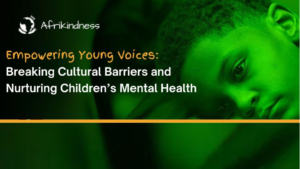
It is never too early to help and encourage children to grow into thoughtful, kind, and respectful global citizens.
As parents or caregivers, it is important to create an inclusive environment for all children, regardless of their unique needs and abilities.
Each individual has a unique way of thinking, learning, and processing information. Neurodiversity refers to the recognition and acceptance of these differences, as each person’s brain functions distinctly, leading to unique experiences of the world around them. These differences may be more noticeable for individuals with conditions such as autism, ADHD, or dyslexia.
According to spectrum news UK, “About 1.8% of school children in England are autistic. The prevalence is highest among black children — about 2.1%.”
Teaching children about neurodiversity is one of the steps to teaching children to value diversity.
This supports a culture of kindness, tolerance, understanding, and empathy in children, and is also a good way to encourage children to take pride in their uniqueness.

What Is Neurodiversity?
Neurodiversity is about acknowledging and accepting the fact that our brains are all wired a little differently and that this diversity of neurological function is a natural and valuable part of human diversity.
The idea behind neurodiversity is that there’s no one “right” way for a brain to work. Some people might process information more quickly or in a different way than others or might have a harder time with certain tasks.
And that’s okay!
Instead of seeing these differences as problems that need to be fixed, neurodiversity views them as natural variations in the way that human brains work.
One of the coolest things about neurodiversity is that it challenges the idea of a “normal” or “typical” brain. What society defines as “normal” is heavily influenced by cultural, social, and historical factors, rather than any inherent biological or scientific truth.
So, instead of trying to force everyone to fit into this narrow definition of “normal,” neurodiversity celebrates the diversity of human brains and recognizes that everyone has something unique to offer.

Why Should We Talk to Children About Neurodiversity?
It is beneficial to have conversations with children about these differences to foster an environment of acceptance and understanding toward those who may be different from them. It helps them understand that everyone is different and that those differences should be celebrated, not stigmatized.
When children learn about neurodiversity, they can develop empathy and understanding toward their peers who may think or learn differently than they do. They can also learn to appreciate the unique strengths and perspectives that neurodivergent individuals bring to the table.
In addition, talking to children about neurodiversity can help reduce the stigma and stereotypes surrounding neurological differences.
By teaching children that neurodivergent individuals have valuable contributions to make, we can help promote a more inclusive and accepting society.
This can benefit not only neurodivergent individuals but also society as a whole by encouraging diverse perspectives and ideas.

How Do I Talk to My Child About Neurodiversity?
Not sure where to start? Here are 7 tips on how to speak to your child about Neurodiversity:
1. Use Age-Appropriate Language
When speaking to children about neurodiversity, it’s important to use age-appropriate language. Use simple, clear language that they can easily understand. Avoid using technical terms or jargon that may be confusing or overwhelming. By using age-appropriate language, you can help children develop a basic understanding of neurodiversity and appreciate the unique strengths and challenges of neurodivergent individuals.
2. Emphasize the Positives
By highlighting the strengths and positive qualities that neurodivergent individuals possess, children can learn to appreciate the unique perspectives and contributions that neurodiversity can bring to the world.
For example, children can learn that individuals with autism may have exceptional focus and attention to detail, while individuals with ADHD may have high energy and creativity. Similarly, individuals with dyslexia may have strong problem-solving skills and excellent spatial reasoning abilities.
3. Avoid Stereotypes
Neurodivergent individuals are unique individuals with their strengths, challenges, and personality traits, and should not be reduced to stereotypes or labels. For example, not all individuals with autism are math geniuses, and not all individuals with ADHD are hyperactive and unfocused.
Similarly, individuals with dyslexia may have varying degrees of difficulty with reading and should not be labelled as “lazy” or “slow”.
Instead of perpetuating stereotypes, it’s important to focus on the individual and their unique experiences and perspectives.
4. Encourage Questions
When discussing neurodiversity with your child, it is important to create an environment that encourages curiosity and questions. One way to do this is by starting with what your child already knows and building on their existing understanding. You can ask questions such as “Have you ever noticed that some people have different ways of communicating?” or “Do you know anyone who learns differently than you do?” This approach can help your child feel more comfortable and confident in asking questions about neurodiversity.
Another way to encourage questions is by actively listening and validating your child’s thoughts and feelings. It is important to create a safe space where your child feels heard and respected.
5. Use Stories and Examples
Using stories and examples is an effective way to help children understand and relate to the concept of neurodiversity.
By using real-life examples, stories, and characters, you can help your child gain insight into the experiences of individuals with different neurological conditions.
For example, you can share a story about a person with autism and their unique strengths and challenges or about a celebrity who has spoken about being on the autism spectrum.
6. Encourage Empathy and Understanding
Encouraging empathy and understanding is an important part of talking to your child about neurodiversity. One way to encourage empathy is by teaching your child to put themselves in other people’s shoes. You can ask your child how they would feel if they were in the same situation as someone with a neurodiverse condition, or how they might react if they had a different way of thinking or processing information. Additionally, you can use age-appropriate language and real-life examples to help your child understand the experiences of individuals with neurodiverse conditions. It is also important to emphasize the importance of respecting and accepting differences.
7. Read Books and TV Programs
Reading books and watching TV programs can be a great way to introduce your child to the concept of neurodiversity. Many books and TV programs feature characters with neurodiverse conditions and can help your child understand the experiences of individuals with these conditions.
Reading books or watching programs together can also open up opportunities for important discussions and questions. As you read or watch, you can ask your child what they think about the characters and their experiences, and help them develop empathy and understanding.
Talking to your child about neurodiversity is an important step toward creating a more inclusive and accepting world. By promoting empathy, understanding, and respect for differences, you can help your child develop a positive attitude toward individuals with neurodiverse conditions. Encouraging questions, using stories, reading books, and watching TV programs are effective ways to introduce your child to the concept of neurodiversity.
Remember that talking about neurodiversity is an ongoing conversation, and it is essential to keep the dialogue open.
As your child grows and develops, their understanding of neurodiversity will also evolve. Therefore, it is crucial to continue to provide opportunities for discussion and education.
Finally, it is important to remember that every individual is unique, regardless of whether they have a neurodiverse condition or not.
Embracing diversity and promoting acceptance & kindness is crucial in helping all individuals reach their full potential, regardless of their differences.
Let’s work together to create a world where everyone is accepted for who they are.

Our Call to Action
Spark open conversations with your children about neurodiversity!
Encourage questions, share stories, and explore diverse perspectives. Together, let’s create a world where everyone is embraced for who they are.
#NeurodiversityTalks










